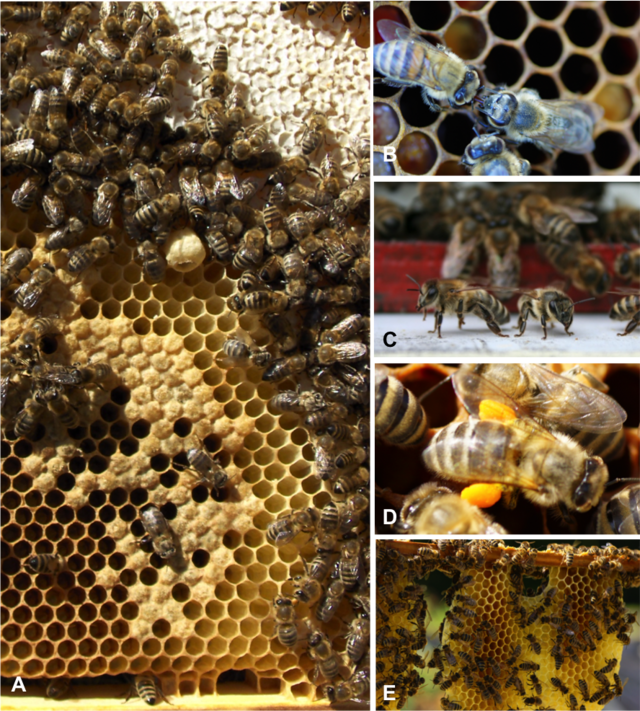Social behavior and colony organization
Insects, such as honeybees, can form societies in which thousands of members integrate their behaviors to such an extent that they become a single functional unit 1. The formation of such societies is a major evolutionary transition, occurring in honeybees during the last 60 million years. Workers in honeybee societies engage in different tasks, collaborate, and communicate in performing their labor, just as people do in human societies. Through their collective effort, novel properties emerge at the level of the society that far exceed the capabilities of single workers. Honeybees collectively defend their colonies, efficiently exploit food sources through sophisticated communication systems (such as waggle-dance behaviors), and begin rearing the strong spring worker force before winter is over. These group-level adaptions, among others, led to honeybees’ great ecological and economic importance and to their dominance in pollination. Eighty percent of wild flowers are pollinated by honeybees, and the increase in crop yield resulting from honeybee pollination amounts to a value of €21 billion per year in the European Union alone.
Honeybees divide reproduction among female castes. A single queen and the several hundred males perform the behaviors devoted to reproduction, while the 10,000 to 40,000 female workers perform the social behaviors devoted to maintaining the honeybee colony. Honeybee workers engage in more than 20 behavioral tasks, including cell cleaning, brood feeding, comb building, foraging, food storage, and more (Fig. 1)2. The rich behavioral repertoire and social interactions of honeybee workers are controlled by a brain comprising roughly 1 million neurons3. The evolutionary rise of social organization is associated with the origin of the worker caste displaying social behaviors.

Our research so far has found that substantial genetic variation influences social behaviors in honeybee populations, variation that is a possible source of future adaptions and selection programs4-7. Only a few genomic loci affect the probability of engaging in behavioral tasks, such as foraging4-6. For the hygienic behavior, we showed that the worker behaviors and their brains’ molecular state are influenced by the genotype of their social partners7. Genetic effects arising from social interactions affect colony-level output, that is, the number of cleaned brood cells. Colony organization results from dynamic interactions between and behavioral performances of workers that are specified by a genetically encoded program.
However, how social organization is controlled by workers’ brains, how this control is specified during development, and how neural control over social organization has evolved at the molecular level remains one of the most important questions in the study of insect societies.
We introduced a genetic manipulation tool8 that opens new avenues for research by compromising selected brain functions of honeybees (Fig. 2). To examine those effects on worker behavioral performance and the society-level outcomes deriving from those effects, we established the automatic tracking of workers in small observation colonies using workers labeled with QR-codes9 for automatic, computer-based behavioral annotations (Fig. 3).


1 Hölldobler, B. & Wilson, E. O. The superorganism : the beauty, elegance, and strangeness of insect societies. (W.W. Norton, 2009).
2 Seeley, T. D. The Wisdom of the Hive., ( Harvard University Press., 1995).
3 Menzel, R. The honeybee as a model for understanding the basis of cognition. Nature reviews. Neuroscience 13, 758-768, doi:10.1038/nrn3357 (2012).
4 Hunt, G. J. et al. Behavioral genomics of honeybee foraging and nest defense. Naturwissenschaften 94, 247-267 (2007).
5 Rueppell, O. et al. The genetic architecture of sucrose responsiveness in the honeybee (Apis mellifera L.). Genetics 172, 243-251 (2006).
6 Rueppell, O. et al. The genetic architecture of the behavioral ontogeny of foraging in honeybee workers. Genetics 167, 1767-1779 (2004).
7 Gempe, T., Stach, S., Bienefeld, K. & Beye, M. Mixing of honeybees with different genotypes affects individual worker behavior and transcription of genes in the neuronal substrate. PloS one 7, e31653, doi:10.1371/journal.pone.0031653 (2012).
8 Schulte, C., Theilenberg, E., Muller-Borg, M., Gempe, T. & Beye, M. Highly efficient integration and expression of piggyBac-derived cassettes in the honeybee (Apis mellifera). Proc Natl Acad Sci U S A 111, 9003-9008, doi:10.1073/pnas.1402341111 (2014).
9 Mersch, D. P., Crespi, A. & Keller, L. Tracking individuals shows spatial fidelity is a key regulator of ant social organization. Science 340, 1090-1093, doi:10.1126/science.1234316 (2013).

